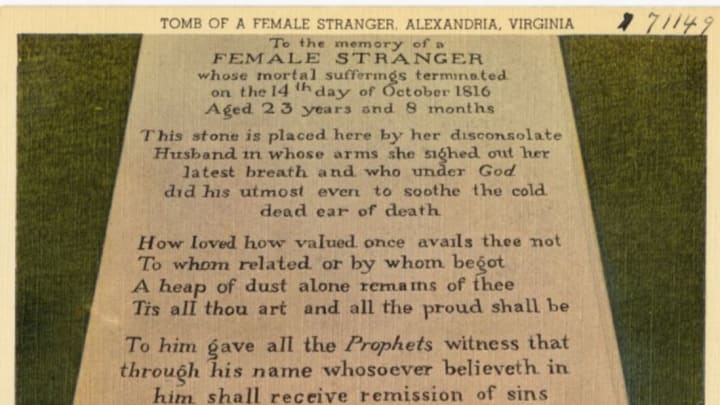In 1816, local legend has it that a ship dropped off an unknown couple in Alexandria, Virginia. The woman was extremely ill, possibly from typhoid fever, and couldn’t wait until their final destination to receive medical attention.
Alas, it was too late; she died a few weeks later while boarding at Gadsby’s Tavern. No one had spoken to her or, some say, even seen her face—any time anyone saw her, her features were hidden by a long, black veil. Her husband quickly arranged for a burial at St. Paul’s Cemetery, then borrowed money for a headstone from a local merchant named Lawrence Hill.
Under the circumstances, you might think the mysterious man would keep the epitaph simple, resulting in a more affordable stone and a smaller loan to repay. Instead, he went the opposite route, having a huge marker etched with this wordy tribute:
“To the memory of a Female Stranger, whose mortal sufferings terminated on the 14th day of October, 1816 Aged 23 years and 8 months. This stone is placed here by her disconsolate husband in whose arms she sighed out her latest breath, and who under God did his utmost even to soothe the cold dead ear of death."
It was followed by some verses adapted from Alexander Pope and a Bible quote, adding even more to the bill. The man spared no expense, and it’s no wonder—he apparently had no intention of paying back the loan. The female stranger’s husband skipped town without paying doctor bills, lodging bills, or funeral and burial fees (he did leave behind some currency, but it was forged). And when he left, he took more than his wallet with him—he also took his wife’s identity.
Rumors ran rampant, even 70 years later: In 1886, the Lawrence Gazette reported on several theories, including the popular notion that the woman was really Theodosia Burr Alston, the daughter of Aaron Burr. Alston had been lost at sea around 1812, but conspiracy theorists speculated that she faked her disappearance to escape a loveless marriage. “Why the stranger’s husband would permit no one to see her face after she was dead gives rise to the supposition that he may have feared its recognition by those who looked upon it,” the Gazette said.
Outlandish? Perhaps. But even more so is the tale that the woman was actually a man—Napoleon Bonaparte dressed in drag, to be exact, attempting to escape his exile.
Yet another story declared the woman was named Blanche Fordan, and the man claiming to be her husband had actually hypnotized her into marrying him, though she really loved another.
Sadly, if you're looking for answers, you're going to be disappointed—we still don't have any. The female stranger remains as mysterious today as she was 200 years ago, although her grave has since become a local tourist attraction.
